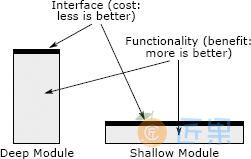最好的模块是那些提供强大功能但具有简单接口的模块。我用“深入”一词来描述这样的模块。为了形象化深度的概念,假设每个模块都由一个矩形表示,如图 4.1 所示。每个矩形的面积与模块实现的功能成比例。矩形的顶部边缘代表模块的接口;边缘的长度表示接口的复杂性。最好的模块很深:它们在简单的接口后隐藏了许多功能。深度模块是一个很好的抽象,因为其内部复杂性的很小一部分对其用户可见。
图 4.1:深浅模块。最好的模块很深:它们允许通过简单的接口访问许多功能。浅层模块是具有相对复杂的接口的模块,但功能不多:它不会掩盖太多的复杂性。
模块深度是考虑成本与收益的一种方式。模块提供的好处是其功能。模块的成本(就系统复杂性而言)是其接口。模块的接口代表了模块强加给系统其余部分的复杂性:接口越小越简单,引入的复杂性就越小。最好的模块是那些收益最大,成本最低的模块。接口不错,但更多或更大的接口不一定更好!
Unix 操作系统及其后代(例如 Linux)提供的文件 I/O 机制是深层接口的一个很好的例子。I/O 只有五个基本系统调用,带有简单签名:
int open(const char* path, int flags, mode_t permissions);
ssize_t read(int fd, void* buffer, size_t count);
ssize_t write(int fd, const void* buffer, size_t count);
off_t lseek(int fd, off_t offset, int referencePosition);
int close(int fd);
开放系统调用采用分层文件名,例如/ a / b / c,并返回一个整数文件描述符,该描述符用于引用打开文件。open 的其他自变量提供可选信息,例如是否正在打开文件以进行读取或写入,如果不存在现有文件则是否应创建新文件,以及如果创建新文件则具有文件的访问权限。读写系统调用在应用程序内存和文件的缓冲区之间传输信息。close 结束对文件的访问。大多数文件是按顺序访问的,因此这是默认设置。但是,可以通过调用 lseek 系统调用来更改当前访问位置来实现随机访问。
Unix I/O 接口的现代实现需要成千上万行代码,这些代码可以解决诸如以下的复杂问题:
- 如何在磁盘上表示文件以便有效访问?
- 如何存储目录,以及如何处理分层路径名以查找它们所引用的文件?
- 如何强制执行权限,以使一个用户无法修改或删除另一用户的文件?
- 如何实现文件访问?例如,如何在中断处理程序和后台代码之间划分功能,以及这两个元素如何安全通信?
- 在同时访问多个文件时使用什么调度策略?
- 如何将最近访问的文件数据缓存在内存中以减少磁盘访问次数?
- 如何将各种不同的辅助存储设备(例如磁盘和闪存驱动器)合并到单个文件系统中?
所有这些问题,以及更多的问题,都由 Unix 文件系统实现来解决。对于调用系统调用的程序员来说,它们是不可见的。多年来,Unix I/O 接口的实现已经发生了根本的发展,但是五个基本内核调用并没有改变。
深度模块的另一个示例是诸如 Go 或 Java 之类的语言中的垃圾收集器。这个模块根本没有接口。它在后台进行隐形操作以回收未使用的内存。由于将垃圾收集消除了用于释放对象的接口,因此向系统中添加垃圾回收实际上会缩小其总体接口。垃圾收集器的实现非常复杂,但是使用该语言的程序员无法发现这种复杂性。
诸如 Unix I/O 和垃圾收集器之类的深层模块提供了强大的抽象,因为它们易于使用,但隐藏了巨大的实现复杂性。
The best modules are those that provide powerful functionality yet have simple interfaces. I use the term deep to describe such modules. To visualize the notion of depth, imagine that each module is represented by a rectangle, as shown in Figure 4.1. The area of each rectangle is proportional to the functionality implemented by the module. The top edge of a rectangle represents the module’s interface; the length of that edge indicates the complexity of the interface. The best modules are deep: they have a lot of functionality hidden behind a simple interface. A deep module is a good abstraction because only a small fraction of its internal complexity is visible to its users.
Figure 4.1: Deep and shallow modules. The best modules are deep: they allow a lot of functionality to be accessed through a simple interface. A shallow module is one with a relatively complex interface, but not much functionality: it doesn’t hide much complexity.
Module depth is a way of thinking about cost versus benefit. The benefit provided by a module is its functionality. The cost of a module (in terms of system complexity) is its interface. A module’s interface represents the complexity that the module imposes on the rest of the system: the smaller and simpler the interface, the less complexity that it introduces. The best modules are those with the greatest benefit and the least cost. Interfaces are good, but more, or larger, interfaces are not necessarily better!
The mechanism for file I/O provided by the Unix operating system and its descendants, such as Linux, is a beautiful example of a deep interface. There are only five basic system calls for I/O, with simple signatures:
int open(const char* path, int flags, mode_t permissions);
ssize_t read(int fd, void* buffer, size_t count);
ssize_t write(int fd, const void* buffer, size_t count);
off_t lseek(int fd, off_t offset, int referencePosition);
int close(int fd);
The open system call takes a hierarchical file name such as /a/b/c and returns an integer file descriptor, which is used to reference the open file. The other arguments for open provide optional information such as whether the file is being opened for reading or writing, whether a new file should be created if there is no existing file, and access permissions for the file, if a new file is created. The read and write system calls transfer information between buffer areas in the application’s memory and the file; close ends the access to the file. Most files are accessed sequentially, so that is the default; however, random access can be achieved by invoking the lseek system call to change the current access position.
A modern implementation of the Unix I/O interface requires hundreds of thousands of lines of code, which address complex issues such as:
- How are files represented on disk in order to allow efficient access?
- How are directories stored, and how are hierarchical path names processed to find the files they refer to?
- How are permissions enforced, so that one user cannot modify or delete another user’s files?
- How are file accesses implemented? For example, how is functionality divided between interrupt handlers and background code, and how do these two elements communicate safely?
- What scheduling policies are used when there are concurrent accesses to multiple files?
- How can recently accessed file data be cached in memory in order to reduce the number of disk accesses?
- How can a variety of different secondary storage devices, such as disks and flash drives, be incorporated into a single file system?
All of these issues, and many more, are handled by the Unix file system implementation; they are invisible to programmers who invoke the system calls. Implementations of the Unix I/O interface have evolved radically over the years, but the five basic kernel calls have not changed.
Another example of a deep module is the garbage collector in a language such as Go or Java. This module has no interface at all; it works invisibly behind the scenes to reclaim unused memory. Adding garbage collection to a system actually shrinks its overall interface, since it eliminates the interface for freeing objects. The implementation of a garbage collector is quite complex, but that complexity is hidden from programmers using the language.
Deep modules such as Unix I/O and garbage collectors provide powerful abstractions because they are easy to use, yet they hide significant implementation complexity.
